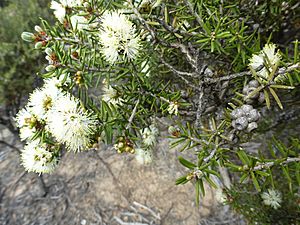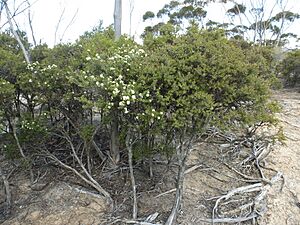Melaleuca pauperiflora facts for kids
Quick facts for kids Melaleuca pauperiflora |
|
|---|---|
 |
|
| M. pauperiflora leaves, flowers and fruit | |
| Scientific classification | |
| Genus: |
Melaleuca
|
| Species: |
pauperiflora
|
| Subspecies | |
|
|
Melaleuca pauperiflora, often called boree, is a special plant from the myrtle family, Myrtaceae. You can find it growing in the southern parts of South Australia and Western Australia. This plant is easy to spot because of its short, thick leaves. It also has many small white or cream-colored flowers. There are three different types, or subspecies, of this plant.
Contents
What Does it Look Like?
Melaleuca pauperiflora can be a large bush or a small tree. It usually grows up to about 6 metres (20 feet) tall. It has rough, grey bark that feels like fibres.
The leaves of this plant are a bit different depending on the type. Generally, they are 3 to 13 millimetres (0.1 to 0.5 inches) long. They are also very narrow, about 0.8 to 1.7 millimetres (0.03 to 0.07 inches) wide. The leaves are shaped like a very thin oval or a line. They are almost round if you cut them in half. The ends of the leaves can be blunt, pointed, or sharp.
The flowers are white or light yellow. They grow in round, half-circle shapes, mostly at the ends of branches. These branches keep growing even after the flowers bloom. Sometimes, flowers also grow where the leaves meet the stem. Each flower head is about 18 millimetres (0.7 inches) across. It holds 3 to 10 individual flowers.
The petals are 1.7 to 3 millimetres (0.07 to 0.1 inches) long. They fall off as the flower gets older. Inside the flower, there are five groups of stamens, which are the parts that hold pollen. Each group has 10 to 18 stamens.
This plant blooms in spring and early summer. After the flowers, it grows woody, barrel-shaped fruits. These fruits are called capsules and are spread out along the branches.
How it Got its Name
The plant Melaleuca pauperiflora was first officially described in 1862. This was done by Ferdinand von Mueller, a famous botanist. He wrote about it in his book "Fragmenta phytographiae Australiae." He studied a plant sample collected by George Maxwell from the Phillips Range.
The second part of its scientific name, pauperiflora, comes from two Latin words. Pauper means "poor" and flos means "flower" or "blossom." Mueller named it this because the plant sample he looked at only had a few flowers.
In 1988, two scientists, Bryan Barlow and Kirsten Cowley, looked closely at the Melaleuca group of plants. They found three different types, or subspecies, of Melaleuca pauperiflora:
- Melaleuca pauperiflora subsp. fastigiata: This type grows in Western Australia. You can find it around the areas of Wubin, Kulin, Esperance, and Norseman.
- Melaleuca pauperiflora subsp. mutica: This type is found in South Australia. It grows especially on the Eyre Peninsula, in the Nullarbor Plain, and as far east as Murray Bridge.
- Melaleuca pauperiflora subsp. pauperiflora: This type also grows in Western Australia. It is found between the South Yilgarn, Ongerup, and Salmon Gums areas.
Where Does it Grow?
Melaleuca pauperiflora grows in the southwest part of Western Australia and the southern part of South Australia. It can grow in many different types of plant communities and soils. Where it grows often depends on which subspecies it is.
Plant Friends
Some insects are very important for Melaleuca pauperiflora. Jewel beetles, especially a type called Temognatha heros, help to pollinate the flowers. Pollination is when pollen is moved from one flower to another, helping the plant make seeds.
Keeping it Safe
The Government of Western Australia's Department of Parks and Wildlife has looked at this plant. They have said that Melaleuca pauperiflora is "not threatened." This means it is not in danger of disappearing.
What is it Used For?
Gardening
While this plant might not be super popular for gardens, it is very tough. It can grow well in dry places. This makes it useful if you need a plant to create a screen or hedge in areas without much water.
Special Oils
Of the three types of Melaleuca pauperiflora, the mutica subspecies has the most oil in its leaves. This oil is mostly made of substances called monoterpenoids. A main part of this oil is 1,8-cineole, also known as eucalyptol.


